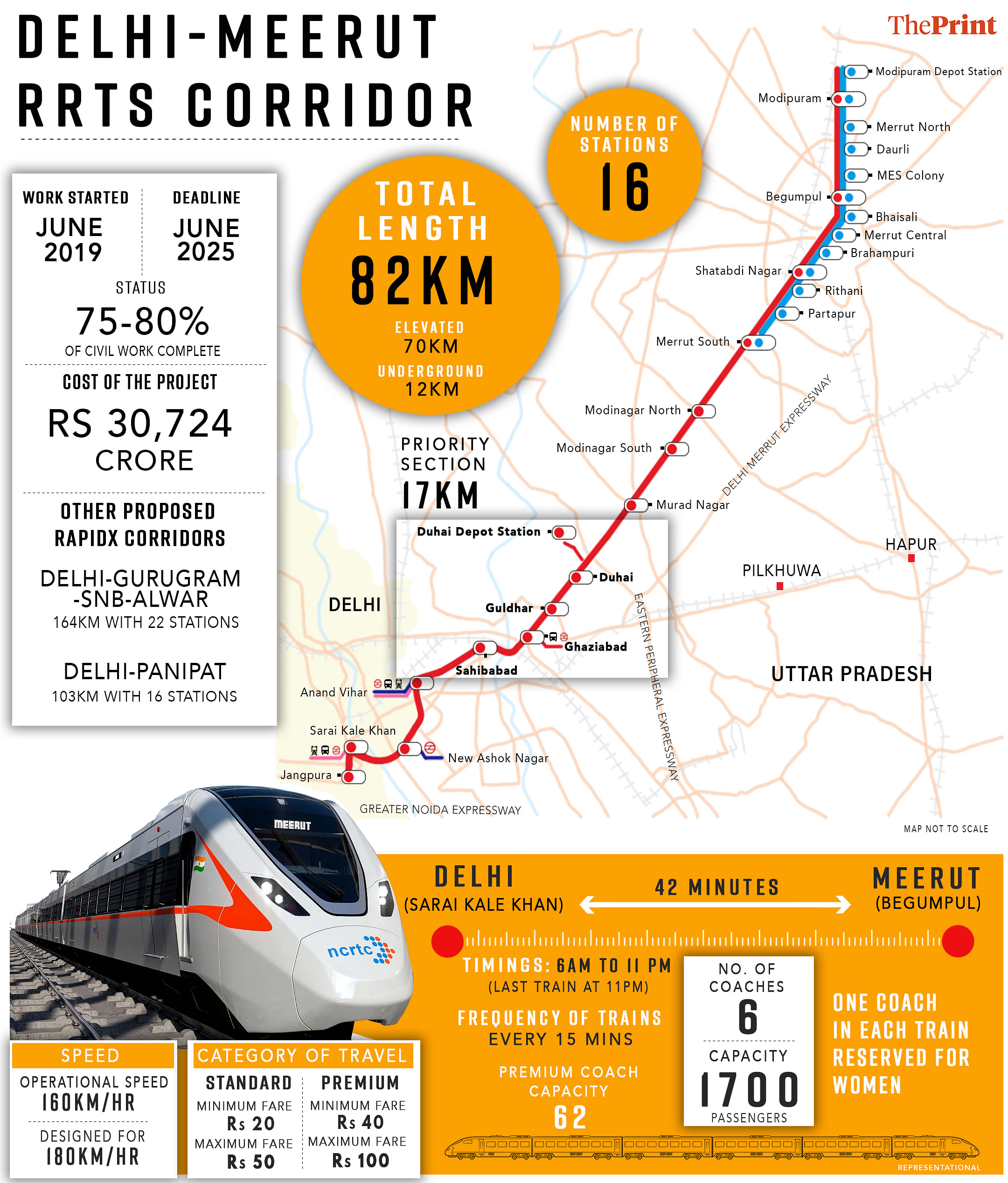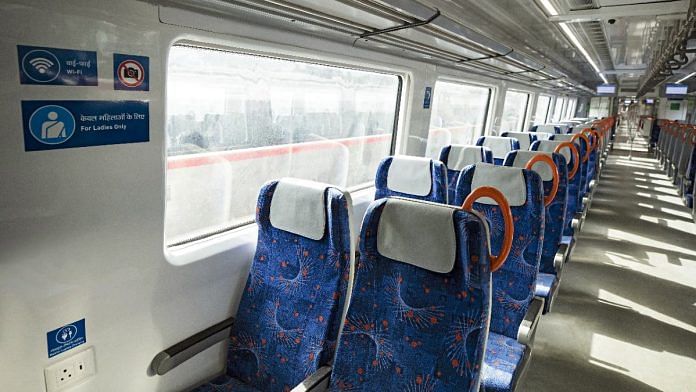New Delhi: India’s first Regional Rapid Transport System (RRTS) will be known as Namo Bharat, Union Housing and Urban Affairs Minister Hardeep Singh Puri said Thursday. Prime Minister Narendra Modi will inaugurate the priority section of the Delhi-Meerut RRTS Friday.
In a post on X (formerly Twitter) in Hindi, Puri said, “The Priority Corridor #RRTS project related to the aspirations of crores of people is ready to get on track. PM Shri @narendramodi ji will dedicate it to the nation tomorrow i.e. on 20th October. This regional rapid transit system of the country will be known as #NaMoBharat.”
This is the second time the name of the RRTS, which is being developed by the National Capital Region Transport Corporation (NCRTC), has been changed. In April this year, the RRTS project was named RAPIDX and a logo of the new high-speed mass transit project was released by NCRTC.
In another post, Puri said, “Inauguration of the country’s first Regional Rapid Train #NamoBharat between Sahibabad & Duhai Depot by PM Sh@narendramodi Ji on 20 October 2023 will mark the beginning of a new era of state-of-the-art ultra-modern urban commute in the country.”
After it is inaugurated Friday, the first section of the 82km RRTS — a 17km stretch from Duhai Depot (in Ghaziabad) to Sahibabad near the Delhi border — will open to the public Saturday.
The project, when fully operational, aims to cut travel time between Delhi and Meerut to less than an hour.
The idea is to give commuters between Delhi and the Uttar Pradesh side of the NCR, who go back and forth daily for work or otherwise, a comfortable alternative to road travel.
This is expected to help decongest the capital’s roads, with the five-year-old Delhi-Meerut Expressway seeing as many as 1 lakh vehicles on its busiest days.
Fares for the 17km stretch — or priority section — will range from Rs 30-50 for ordinary coaches to Rs 60-100 for premium class (which comes with its own exclusive boarding lounge). An official of the National Capital Regional Transport Corporation (NCRTC) said these fares are only for this stretch and not for the entire Delhi-Meerut corridor.
The 17km priority corridor will have five stations, Sahibabad, Ghaziabad, Guldhar, Duhai and Duhai Depot, and a travel time of 15 minutes. Initially, trains will be available every 15 minutes.
“If a passenger enters and exit from the same station, then he/she will have to pay Rs 20 for standard class and Rs 40 for premium class,” the official added.
NCRTC officials said that passengers in both standard and premium class will be allowed to carry luggage weighing up to 25 kg.
“Passenger operations will begin on 21 October after the inauguration. The RAPIDX operations on priority section will be between 6am and 11pm. The last train from the two ends will be available at 11 pm,” said Puneet Vats, Chief Public Relations Officer, NCRTC. “Trains will run at a speed of 160kmph, though the system is designed for 180kmph speed.”
Vats said the system is “estimated to take close to one lakh passenger vehicles off the road once fully operational”.
The entire Rs 32,724-crore Delhi-Meerut RAPIDX corridor is expected to be operational by June 2025.
This is one of three RRTS corridors to ease travel within the NCR, and experts say such initiatives could go a long way in not just decongesting Delhi roads, but also easing the region’s endemic pollution woes.
Also Read: Delhi NCR’s colonies are different from Western cities. The poor are closer to you
Delhi-Meerut: a priority corridor
The 82km Delhi-Meerut is a crucial corridor, as lakhs of people come to Delhi from Meerut and neighbouring areas for work and business.
Once the entire stretch is operational, NCRTC officials said, it will take less than an hour to reach Meerut from Delhi’s Sarai Kale Khan. The NCRTC is expecting a ridership of around eight lakh per day in the initial years.
A senior NCRTC official said, “Each train will have six coaches, including one each for premium category and women, and carry around 1,700 passengers. Each train will have seating for 134 passengers, including 62 seats in the premium coach. The premium coach will be accessible only through a premium lounge made at the platform level.”

For the first time, the NCRTC has implemented a two-stage functionality in the Automated Fare Collection system.
“The AFC system will have gates on both the concourse and platform levels of the stations. Commuters will be able to access the paid area at the concourse and the standard-class boarding area at the platform level via concourse-level gates,” an NCRTC official said. “To access the premium coach, commuters will have to tap again at the platform level on the AFC provided at the entrance to the Premium Lounge.”
Transport planning experts say that, once the RRTS corridor is fully functional, it will have a significant impact on traffic congestion in Delhi-NCR.
Over the years, the traffic volume on the Delhi Meerut Expressway, which was inaugurated in 2018, has seen a marked increase.
“The traffic volume on the entire highway varies between 30,000 and a lakh vehicles per day,” said an official of the National Highways Authority of India (NHAI).
Speaking to ThePrint, Indian Railways officials said there are currently 26 trains that operate between Delhi and Meerut, with an average travel time of 1.5-2 hours.
“It (the RRTS) is going to provide an alternative mode of transportation to people. The idea is to get people who use their cars to switch to this high-speed mode,” said E. Madhu, chief scientist and head of transport planning division, Central Road Research Institute (CSIR-CRRI).
“Even if there is a 5 percent reduction in vehicular traffic between the two cities, it will have a significant impact on congestion and air pollution in the region,” he added.
To popularise this new mode of transportation, Madhu said, multi-modal connectivity is essential.
“The ridership will increase if there is provision for good last-mile connectivity. Also, more such corridors will help in getting more people to switch to RRTS,” he added.
Improving regional connectivity
The idea of an integrated commuter railway network to connect the National Capital Region and Delhi was mooted in 1998-99, but it was only in 2006 that the National Capital Regional Planning Board (NCRPB) took it up as part of the “Functional Plan on transport for NCR-2032”, according to the information available on the NCRTC website.
While the NCRPB’s functional plan on transport proposed eight RRTS corridors, three were taken up on priority basis: Delhi-Meerut, Delhi-Gurgaon-Alwar, Delhi-Panipat.
The other two corridors are yet to get approvals from the Centre and state governments.
This is an updated version of the report
(Edited by Sunanda Ranjan)
Also Read: Two development plans for Delhi-NCR stuck for 2 years. Here’s what the hold-up is



